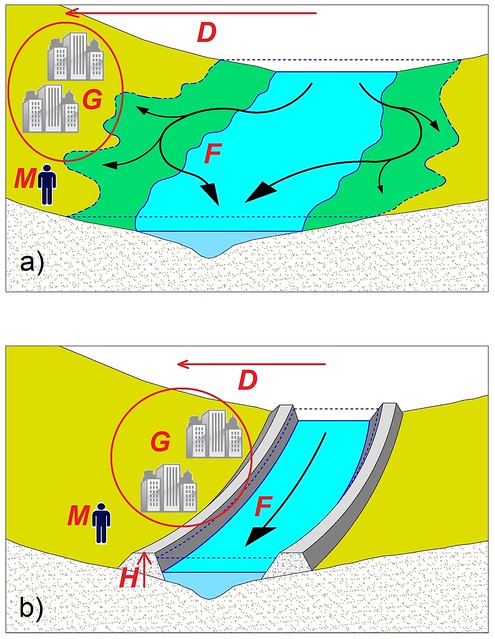 Flood control to keep water out of houses seems like a good idea,
but it turns out that it causes the flood control measures to keep
needing to be raised higher, and it encourages people to build
too close to flooding areas, plus
“rare and catastrophic events take place”.
Like the 2009 “700 year flood” and the
four or more floods this year
that have overflowed the Withlacoochee Wastewater Treatment Plant.
In our case, there are also the issues of widespread clearcutting
and buildings and streets with impervious cover.
The local runoff containment requirements in the various local government zoning codes may be
like levees: “flood control
structures might even increase flood risk as protection from
frequent flooding reduces perceptions of risk”.
Flood control to keep water out of houses seems like a good idea,
but it turns out that it causes the flood control measures to keep
needing to be raised higher, and it encourages people to build
too close to flooding areas, plus
“rare and catastrophic events take place”.
Like the 2009 “700 year flood” and the
four or more floods this year
that have overflowed the Withlacoochee Wastewater Treatment Plant.
In our case, there are also the issues of widespread clearcutting
and buildings and streets with impervious cover.
The local runoff containment requirements in the various local government zoning codes may be
like levees: “flood control
structures might even increase flood risk as protection from
frequent flooding reduces perceptions of risk”.
This encourages human settlements in floodplain areas, which are then vulnerable to high-consequence and low-probability events.Much simpler just not to give out building permits for flood zones. Or we could put medical buildings right next to a creek, assuming because it’s never flooded it never will….
Socio-hydrology: conceptualising human-flood interactions, G. Di Baldassarre, A. Viglione, G. Carr, L. Kuil, J. L. Salinas, and G. Bloschl, Hydrol. Earth Syst. Sci., 17, 3295–3303, 2013 doi:10.5194/hess-17-3295-2013, © Author(s) 2013. CC Attribution 3.0 License.
Abstract. Over history, humankind has tended to settle near streams because of the role of rivers as transportation corridors and the fertility of riparian areas. However, human settlements in floodplains have been threatened by the risk of flooding. Possible responses have been to resettle away and/or modify the river system by building flood control structures. This has led to a complex web of interactions and feedback mechanisms between hydrological and social processes in settled floodplains. This paper is an attempt to conceptualise these interplays for hypothetical human-flood systems. We develop a simple, dynamic model to represent the interactions and feedback loops between hydrological and social processes. The model is then used to explore the dynamics of the human-flood system and the effect of changing individual characteristics, including external forcing such as technological development. The results show that the conceptual model is able to reproduce reciprocal effects between floods and people as well as the emergence of typical patterns. For instance, when levees are built or raised to protect floodplain areas, their presence not only reduces the frequency of flooding, but also exacerbates high water levels. Then, because of this exacerbation, higher flood protection levels are required by society. As a result, more and more flooding events are avoided, but rare and catastrophic events take place.
Fig. 1. Schematic of human adjustments to flooding: (a) settling away from the river, and (b) raising levees or dikes.:
Fig. 2. Historical evolution of the high water levels (left) and levees (right) in the Adige River at Masi (Italy) between 1600 and 1933 (after Da Deppo et al., 2004).:
Fig. 3. Loop diagram showing how hydrological, economical, political, technological, and social processes are all interlinked:
Maybe if we become aware of this problem we’ll stop doing it.
-jsq
Short Link:

